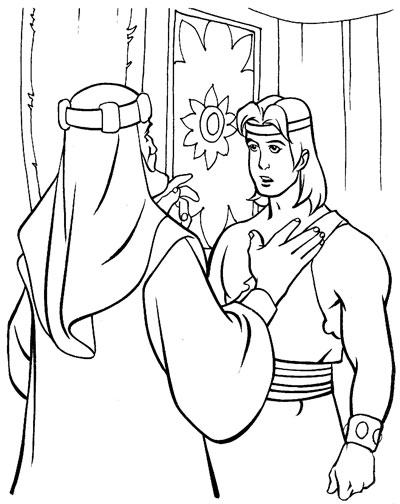I’ve slept better the past two nights than in the past 5 months. My aunt is home now with her 24 hour care, and the pressure I’ve been under is beginning to alleviate. I’m so grateful this all came down at the end of Seminary last year so that I could take care of the management of her home and renovation projects and other sundries when I wasn’t also saddled with the rigors of Seminary teaching. It’s been a long slog, but the end is in sight.
Last week was terribly busy, but I’ll go ahead and summarize our lessons for your information. I dislike (too mild a word) the first lesson in the manual. In fact, I read the title, thought “nope,” and didn’t even bother to read the lesson. I did feel guilty later and started to skim the lesson, but since the first paragraphs sounded like the scold session the title seemed to imply, I dropped it. I hate to say it, but the new lesson manual isn’t proving any more useful to me than the old one. :( I had such high hopes. I will keep trying because I think that the lessons are much better written, but I’m afraid that lessons like these, geared to non-reading students, will not be helpful in my classroom. Additionally, I don’t like many of the suggested activities. They are too advanced for the first few days of Seminary. Some of them are just plain stupid and intended to spark debate instead of highlighting truth. I sure hope it gets better soon.
Anyway, I prefer to begin my classes with us getting straight into the Book of Mormon. As you read earlier, our first day was on the origins of the Book of Mormon. Here is Day 2:
Day 2: Three and Eight Witnesses
The testimonies of the Witnesses, to me, is one of the most compelling things about the Book of Mormon. You can explain away many things about Joseph Smith and his story, but you can’t explain away the Witnesses. Students were assigned to read the testimonies of the witnesses before class and look for differences in the Testimonies. Also before class, I put a sticky note underneath the seats of my students that had each of the 11 witness names, plus Emma Smith, the Angel, and Joseph Smith Jr. I also set a table up in the center of the room.
After a short attention getter where I asked my students who would make a more reliable witness of the book of Mormon — a Seminary student who had read every word, or one who had only read a few verses. We talked about the law of witnesses in some detail.
We then listed differences in the two witness encounters on the board. The students did a great job at this comparison, and we put a list on the board. Some of their comments were very insightful, especially G’s, which noted that the Three testified of the truth of the translation, where the Eight did not. This was a very good discussion. Next I had the kids look for their sticky notes, and assume the roles they were assigned. Funnily, my students with the names Joseph and Emma got Joseph Smith, Jr and Emma Smith, and so I sent them outside to go get my plates and sword replicas from the previous day’s lesson.
Those students returned, and I set up the table. The angel, Joseph Smith Junior, and the Three Witnesses came up, and we talked about that experience while those students looked over the items. My gold plates are build to scale based on “What Did the Golden Plates Look Like” from the July 2007 New Era. I wrote on the last leaf on the left side the text of the Title Page of the Book of Mormon, along with the quote from Joseph Smith about that being translated. On the front I copied some of the characters from the Caracters (Anthon Transcript) document. I told the kids this MAY be what the letters looked like and explained where they came from. They look pretty hinky to me. But it gave a talking point for me to remind students not to get hung up on items like this that fit into the nice-to-know-but-not-testimony-building category. I pointed out the text on the Sword of Laban that reads “This sword will never be sheathed until the kingdoms of this earth become the kingdom of our God and His Christ.” After the Three looked, the Eight came up, and then the rest of the class. I reminded them that we don’t know much about what any of these items looked like, and not to get all hung up on the things I made being perfect replicas.
It was a nice lesson, and I think the kids went home with a better understanding of the reality and nature of these events. I wrapped up with my testimony that even though I’ve not seen the plates, nor did I see an angel, I know the Book of Mormon is true because I’ve read every word and tried to apply the doctrines and principles taught in it in my life. When I’ve done so, my life is better. I strongly encouraged my students to commit to read the Book of Mormon this year so that they, too, can become witnesses.
Day 3: Scripture Study Helps
This is always a fun lesson. Like last year, I split the groups by zone and had the upperclassmen teach their Freshmen how to use the scripture study helps. I admit that I was not well prepared this morning because of things related to getting my aunt home, and my instructions written on the board to assist Seniors in teaching the Freshmen were not fantastic. They had done this before, so it wasn’t too terrible. I also caught a few mistakes in my game, which I’ve now fixed.
After the 6 minute training session, Freshmen came to the couches with the zones sitting behind them. If the Freshman asks for help, they get 1/2 credit. Other groups could steal by being the first to stand after the 30 second time to answer. The final group was a set of harder questions targeted at the Seniors. Two zones were tied for first place, and they were eliminated from the final round. It was fun, though two of my Freshmen are more than a little competitive, and got a little bit too excited. I will keep that in mind….
Here’s a link to Scripture Study Helps Jeopardy for Book of Mormon. I used the link and played it online with the sound effects and stuff. You can use the answers to play it on the chalkboard.
Day 4: Plan of Salvation
Now THIS was an interesting/terrifying/exhausting day. I wish that I had an objective way of evaluating its success, but I did hear some pretty good feedback from the mommas about this one and no one has left the church over it, so I think it was probably okay.
I mentioned that I’ve got an investigator coming to class. It’s caused me to alter my lessons to be sure that I fully explain things on a level that he can also get something from them. I was worried about this lesson, because my regular students would come knowing the basics of the plan and having studied scriptures, too. The investigator is also keeping up with the reading chart, but I was pretty sure this was going to be new to him, and I was right. So during the lesson my Seminary students who have heard this all their lives were asking questions about plurality of Gods and eternal progression, while my investigator was down at the Primary level. By the end of this lesson, I was EXHAUSTED. Talk about mental exertion.
I gave a description of the plan and had students draw a picture of the plan of Salvation WITHOUT using the three planets version they’ve always seen. Mine was a picture of Christ with three arrows coming in (pain, sin, death) and three going out (comfort/peace, forgiveness, resurrection). My favorite was the seed drawing. After that, I answered questions (this was what was so exhausting), and then broke the class into groups to fill out a form on the plan of salvation prior to having Zone Leaders do a 2-3 minute presentation on it. Students were assigned roles of scribe, seeker (finds scriptures with information that they aren’t sure of) and Zone Leader (keeps everyone on track, watches the timer, presents at end) I used a handout I got from SugarDoodle on the plan of Salvation for them to fill out. The form has issues when printed, so it took me a little finagling to get it to work properly.
Anyway, we didn’t have enough time to do presentations, so I put that off to the next day and fielded some more questions about the plan of salvation that came up during discussion. It was a real pleasure to see my students answering the questions of our investigator during our group work. They did a great job.
By Thursday, I was feeling pretty overwhelmed about having the needs of so many varied levels in the classroom, and so I contacted the Ward Mission Leader to see if he could send in the missionaries a couple of days a week to help out with my investigator. I was feeling that I had to alter my lessons significantly to help him understand the material better since he has virtually no background, and I thought having the missionaries in would help. Our WML taught Seminary for 4 years including a stint with an investigator. His advice was to not alter lessons significantly for the investigator and to use the missionaries like salt: sparingly. After our talk, I think he’s right, particularly with these sets of missionaries (we have a set of sisters and a set of elders). Three of them are so green or bumfuzzled with the This-Isn’t-How-I-Imagined-It culture shock that they aren’t very helpful now. Our female missionaries won’t sit near or talk to anyone in the ward. The one is from Boston and ought to know better, and we excuse the other because she’s from Utah, though really, she should know better, too. The male missionaries are trying, and Elder Moon from South Jordan is seasoned enough to be good. He’s the only thing holding the area together right now. Seeing them struggle makes me feel a lot of pressure to help my kids be better prepared for the reality of missionary life when they go out. Some of them could be leaving in just a few short months.
At the end of our group work we had five minutes which was not enough time to do presentations. I told the class we’d start there tomorrow, and I asked our investigator if it was okay to put him on the spot and if he had any questions he’d like to ask the class. He asked, “What is the deal with the Garden of Gethsemane?” His background is Baptist, and my dad later explained that for many churches, the story begins on the cross. This investigator is not confrontational, but he is a Seeker, and an intelligent one, who asks good questions. My students were looking like deer in the headlights, and since he looked me full in the face to ask the question, I picked up the gauntlet. I gave a very brief overview of Christ’s mission, culminating on the cross and at Gethsemane, and I hope I explained enough about what the Atonement accomplished that he understood. After class, I spoke with him a few moments and handed him a copy of True to the Faith. He said, “THIS will answer all my questions about this stuff.” I laughed and told him it probably wouldn’t answer ALL of his questions, but that it would definitely help. He told me he would be meeting with the missionaries on Friday. I’d love to hear how that goes, but I’m not in his ward. :( Luckily it’s my old ward where I was RS president, so I’ve still got contacts. I think we can keep pretty good tabs on him.
Day 5: 1 Nephi 1-2
We started out class by having zone leaders describe parts of the plan of salvation from their handouts yesterday. This probably took about 10 minutes of discussion and fielding questions.
I hadn’t yet talked with the WML when this lesson came around, and so I changed this lesson to give more setting and background than I had originally planned. It worked out nicely, though, and I think that the regular students took information home they didn’t know. For example, most did not know that Nephi was a grown adult when he wrote the First Book of Nephi. They were pleased that the way some of the things were expressed suddenly made more sense. I spent a little time tying the history of the seige of Jerusalem, Zedekiah, and Nebuchadnezzar in with our Old Testament study from two years back. I love to be able to say to the kids “Remember when we studied _____?” I think it helps them see how the scriptures work together.
I am probably the only Seminary teacher in the whole church who skipped right over “I, Nephi, having been born of goodly parents” and went for the nature of God. I wanted to teach my investigator that in order to have faith, one must have a correct idea of the nature of God. This is a valuable lesson even for old timers in the gospel, and I think the lesson was well received. I used Lehi’s reaction to the news that Jerusalem was about to be destroyed as a starting place for the students to list characteristics of God that Lehi obviously knew in order to rejoice after hearing such news. Looking at 1 Nephi 1:13–14, it’s apparent that Lehi knows the Lord is perfectly merciful, good, loves His children, keeps His promises, he’s all powerful, and He won’t let those who come to Him perish. The kids listed these items fairly easily, with the exception of the Lord being trustworthy and keeping His promises. I always point this out because I think that it’s super important for kids to understand that God can be trusted. When He speaks, they can believe Him, and so they can act in faith.
Next we contrasted Lehi’s understanding with Laman and Lemuel in 1 Nephi 2: 12. What didn’t they know? They didn’t know God was powerful, good, merciful, loving, etc. But let’s see about their brother, Nephi, in verse 16. Nephi humbled himself and was able to come to an understanding of God like his father.
This went well, and I think that we laid the groundwork for today’s lesson.
Today, Day 6: 1 Nephi 3-4
I got really frustrated with the lesson for this day that’s in the manual. It was almost entirely useless in terms of a workable lesson outline.
So, instead of the “provoke a debate” lesson opener, I started out by asking the kids what they liked from the reading. They had lots to say. In fact, they said so much that I ended up dropping my opener about all of us having difficult assignments, and just going where they went. We talked probably 15 minutes about their insights into these chapters and how they liked Nephi. One of my students mentioned that her sister on a mission has an investigator who is really struggling with the idea of Nephi killing Laban. I was able to pull out that quote from the manual here to help explain that Nephi killing Laban was acceptable.
I’m struggling to remember how this lesson went because it was so directed by student questions and interest. I know that I used the verses describing Nephi’s wrestle or struggle with the command to kill Laban as an pattern of how the Spirit works on us. We also talked about how we recognize the Spirit. Several of my YW did a great job with this.
We spent a good amount of time talking about how remembering previous lessons, like Nephi did about Moses, can help us. We also talked about how Moses had to go INTO the water before the Red Sea split. That’s faith.
I was going to use some of the questions from the manual as a starting place for a journaling entry, but there wasn’t time, and the direction of the lesson didn’t really go that way.
This lesson felt a lot better to me — probably because I slept better and I am not worrying about my aunt and her care or the construction or the cleaning or the financial advisor or the renters or the bills or the blahblahblah. I am relieved to be getting back to “normal”.
Or at least as normal as life can be for a Seminary teacher :)
Image from http://www.ldsfamilyfun.com/fhe/lessons/fhe_goanddo.htm


